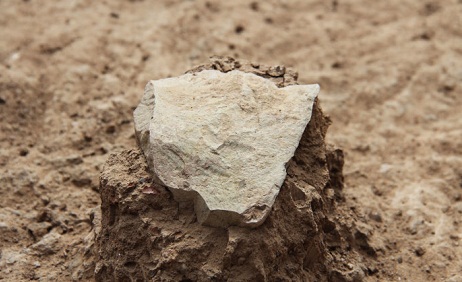Since then, dozens more hominin fossils have been discovered, pushing the earliest evidence of the genus Homo back to 2.8 million years and the earliest Oldowan tools to 2.6 million years. Although many paleoanthropologists have come to doubt that stone tools were the sole province of humans, they remain a proxy for the evolution of intelligence, and scientists have been on the hunt for even older ones. In 2011, Sonia Harmand and her husband, Jason Lewis, both of the Turkana Basin Institute, at Stony Brook University, joined the search. They began by exploring West Turkana, a region of Kenya where, in 1999, Maeve Leakey, the daughter-in-law of Louis and a respected paleontologist in her own right, uncovered a 3.5-million-year-old skull, which she named Kenyanthropus platyops, “flat-faced Kenyan man.” But as they drove through the region’s dry riverbeds in their three-car caravan, Harmand and Lewis’s team got lost. When they went to the top of a hill to get their bearings, they saw a landscape of gray-brown buttes and ravines covered with clumps of desiccated grass. “We felt like this place was incredibly different, so we decided to survey,” Harmand told me recently. She and her colleagues called the site Lomekwi 3. On their first day surveying, they found forty-five stone tools. Today, in a paper in Nature, the team reports a total haul of a hundred and forty-nine tools. They date to 3.3 million years ago, making them the oldest known such specimens by about seven hundred thousand years.
“I knew right away that this place was going to be something,” Harmand said. “The first tool they showed me was obviously knapped.” The broken chunks of basalt and other volcanic rock were much larger than the other stones on the site, indicating that they probably hadn’t arrived there naturally, and many had been struck more than once. (Flaking a stone requires hitting it at particular angles, which rarely happens without intention.) In some cases, the team found flakes that clearly fit the tools nearby. Others of the tools had been made using simpler methods—smashing a cobble against a larger stone that was lying on the ground, or setting a cobble on a larger stone and hammering it with a third. Harmand believes that the motions of the hands and arms needed to fashion these crude tools were similar to those that chimpanzees make when they smash open nuts with stones. It’s possible, she says, that between six and ten million years ago, our last common ancestor with chimpanzees may have been doing something similar. Lewis speculates that the discoveries at Lomekwi may represent a transitional step toward Oldowan-style toolmaking.
One reason that scientists are interested in early tools is that studying them can shed light on the minds that created them. In the nineteen-nineties, two paleoanthropologists at Indiana University, Nicholas Toth and Kathy Schick, ran a series of experiments in which they trained bonobos, a subspecies of chimpanzee, to make stone tools that they could use to cut open a fruit-filled box that was tied shut with rope. Modern apes differ from early human ancestors in important ways. For one, apes have long, sharp incisors that can do the sort of cutting that our dull-toothed ancestors needed sharp stones to accomplish. Still, Toth and Schick learned a lot about how the earliest stone tools were probably made. They noticed that, compared with modern humans, the bonobos had a harder time gripping the stones and aiming where they struck them. Both apes and early hominins had arms and hands that were adapted for life in the trees. The bones in their fingers were longer and curved, well-suited to grasping branches but lacking the precision grip needed for accurate knapping. Nevertheless, the tools that the bonobos produced, though inelegant, were serviceable. “Some of Harmand’s artifacts are reminiscent of what our bonobos were flaking,” Toth told me. “To me, there are similarities in the technology.”
But if the Lomekwi stone tools could have been made by apes, does their manufacture really signify a cognitive leap for humanity? Thomas Wynn, a paleoanthropologist who studies the evolution of human cognition at the University of Colorado, Colorado Springs, thinks not. “There’s nothing about the stone tools that requires big brains,” he said. “And it’s big brains that are really the major defining characteristic of the genus Homo.” (Wynn argues that humans subsequently made superior tools because their brains were better able to process how to hit a stone to give it the desired shape.) And as Toth pointed out, the dearth of equally old tools at other archeological sites suggests that the behavior may have been rare. In the wild, most of the tools that modern apes use are made from leaves and twigs, not from items like stones that might survive millions of years in the ground. “This may be an early experiment in flaking stone that really doesn’t have any longevity,” Toth said. It’s also possible that whatever made the Lomekwi tools wasn’t an ancestor of modern humans.
According to the International Commission on Zoological Nomenclature, there is no official definition of the genus Homo, an indication of just how perplexing the fossil and archeological records have become. It seems clear that the invention of stone tools was critical to our evolution, opening up the diets of early members of the human lineage and providing them with sufficient calories to nourish larger brains, live in bigger social groups, and develop language—the things that distinguish humans from apes. But the innovation doesn’t seem to have happened all at once, or even in one species. Just how smart does an ape need to be before it becomes human? As Lewis put it, the Lomekwi discovery “tells us that the main traits that were important to our lineage’s survival started to show up before the origins of Homo—and that means the dividing line is starting to be less clear.”
More about:
















































